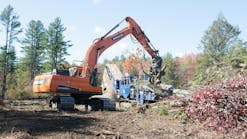If a grader were a person, he might be called ungainly, awkward, or even a klutz. Cynics might say it was only a blade used to push gravel, sand, and snow to the side. “Cumbersome” is what my neighbor named the old grader that turned the gravelly alley behind his house into a smooth thoroughfare again. His mistake was that he watched the machine and not the job it performed. Motor graders are, in fact, some of the most accurate machines in construction. A good number of those yellow, spidery machines have been working efficiently for 20 or 30 years now; you would find it difficult to name a piece of construction equipment that has done better service or offered such longevity.As with all machines whose precise performance sometimes defies the public imagination, the operator has something to do with that success. Many contractors say they try to keep good grader operators when they find them, primarily because getting it right the first time is one of the guaranteed methods of making a job profitable. “The last guy on the job is the grader operator,” says Mitch Stoltenberg at M&S Grading Inc. in Omaha, NE. The company has performed many subdivision projects where the graders do the finish work but also keep the haul roads for scrapers and trucks in good condition. “The grader does the finish work, the last segment of preparation. That is what our customers see. It is the finish accuracy that the customers appreciate, so our grader operators are the most important people for the image and reputation of our company.”Nor do manufacturers belittle the role of the operator. “Technology has come a long way in guiding motor graders,” asserts Bob Post, grader product manager for Komatsu. “There is still a need – and I believe the need will continue for a very long time – for skilled grader operators. There will always be times when the laser or GPS [global positioning system] technology cannot or does not work and an operator will have to do the precise work. Training future grader operators to develop their own skills rather than simply depending on technology should be a prime concern for all dirtmoving contractors.” Volvo Construction Equipment agrees that the importance of the operator cannot be underestimated. “Paying attention to an operator’s needs is vitally important and is the main driver behind our Voice of the Customer development process,” comments Brian Lowe, product and communications manager for Volvo.Homework to DoThat range of sizes mentioned above varies from manufacturer to manufacturer, with all of the specification information you require readily available at the dealership or on the Internet. Many contractors note that the size of the moldboard is as good a place as any to start sizing the machine that would be best for normal work. “If 14 feet is going to be too large for many of your jobs, get a smaller one,” comment several. “If all of your work is in highway-type, wide spaces, get the machine with the most power, best weight, and biggest moldboard,” confirm others. A 12-ft. blade seems especially popular because it can manage a generous 10-ft. pass, but you still can adjust the angle so it is readily transported on an 8-ft. lowboy trailer. One of the points made by New Holland Construction about its graders is that the moldboard is a rollaway design; it can roll the material down the moldboard and not simply doze it.In Case’s 800 Series motor graders, net horsepower ranges from 140 to 205, and operating weights go from almost 30,000 to just less than 38,000 lb. The standard blades vary from 12 ft. on the 845 to 13 ft. on the 865 and 14 ft. on the 885. “We offer the best in serviceability and maintainability,” says David Wolf, marketing manager for Case motor graders. “We have the flip-up rear hood for quick access to the engine, filters, and daily service points. Combine these with drop-down side panels along the bottom of the hood for additional access. The circle has a 360° rotation and externally mounted teeth for easy cleaning, along with additional surface area for reduced wear.” Case joins other manufacturers in its consideration of the operator. “There is a front articulation point so the operator always knows the relationship between the back half of the machine and the front,” adds Wolf. “The ergonomically designed cab offers operator comfort and increased productivity.” On Case graders, the moldboard has “an involuted curved design to boil material in front of the blade with less power and reduced fuel consumption.” New Holland’s graders offer weights from 15,000 lb. (on the RG80) to 35,452 lb. (on the RG200). In the seven models, the horsepower goes from 76 to 205. The biggest model (the RG200) has a top-speed forward of 26.8 mph. Standard moldboard for this model is 14 ft. Its length is 337 in. At the other end of the New Holland range, the RG80 (76 hp) has a top-speed forward of 25.1 mph and a length of 260.6 in., and its standard moldboard is 10 ft.Blade, Weight, and PowerThis Roadrunner attachment goes on the back of a tractor for grading smaller widths.Komatsu America International Company’s Laterra motor graders have what the manufacturer terms a “circular geometry blade.” This feature permits a 90° bank slope position (a “true 90°,” says Komatsu). That promotes easy blade maneuvering while still offering good ground clearance and reach. The design also has two pinions on top of the grader’s saddle for superior support. Komatsu’s GD555-3 Laterra uses a Komatsu SA6D102E turbocharged and aftercooled diesel engine to give 140 hp (160 hp of the GD555 variable horsepower, or VHP, version). The GD655-3 Laterra provides 165 hp (190 hp on the VHP version), and the GD675-3 gives 180 hp (200 hp on the VHP version). The operating weights for these three models go from 30,525 to 34,390 lb. “Small graders are great for tight quarters or if a 12-foot moldboard is all the contractor needs,” says Post. “For heavier-duty jobs, such as spreading stone, a contractor will want more horsepower and weight and probably a bigger moldboard. Weight will also be an advantage if the material to be graded is difficult to penetrate.”“If your application or work site has constantly poor traction conditions, you should consider an all-wheel-drive grader; it can be the solution for increased productivity and, more importantly, getting the job done on time,” says Lowe. “The Volvo G746B All Wheel Drive Grader is the most powerful in the industry. It develops 32,598 pounds of blade pull and is ideal for road construction, road maintenance, ditch cutting, ditch cleaning, snow clearing, and all heavy-duty operations.” The drive system of Volvo All Wheel Drive Models is like having three different drive systems in one grader. In six-wheel drive, all six wheels are powered to grip the ground in poor footing and add an extra 8,500 lb. of pull in front of the moldboard, a practical function for clearing wet ditches and working on bank slopes. With the front drive disengaged, the operator has an efficient tandem-drive grader ready for such operations as top-of-road work or roading. The change from six-wheel drive to tandem drive can be made with the simple flick of a switch. A unique feature of Volvo B Series All Wheel Drive Graders is Creep Mode. The grader also can be operated using the front wheels only, offering infinitely variable ground speed from 0 to 2 mph. Creep Mode allows the moldboard to be pulled, not pushed. “This” the operator the unique capability to perform fine grading without scuffing the work behind the moldboard, even around the tightest radius,” explains Lowe.John Deere graders have a history of successful highway work, on the pavement or the shoulders.Improvements to Caterpillar’s 120H, 135H, and 12H graders were designed to achieve higher productivity and lower operating cost. VHP (variable horsepower) and VHP Plus give the user a more precise delivery of power because the system adjusts according to gear selection. Models 120H and 135H can have VHP to give additional power in fourth through eighth gears. The 12H can be supplied with VHP or with VHP Plus (which gives an additional 11% power when contrasted with the VHP). The 120H has a 125- to 140-hp power range, and the range of the 135H is 135-155 hp. The 12H goes from 145 to 185 hp. The standard blade for all three improved models is 12 ft., and the height of the moldboard is 24 in. Officials at Caterpillar stress the importance of torque in running a grader efficiently. The increased lugging capability on the three models mentioned means that the operator can expect consistent grading speeds without needing to downshift. The maximum rimpull is higher now (11% higher in the 120H and 135H and 14% higher in the 12H). Weights for these three Caterpillar models range from 27,880 to 31,320 lb., and the circle diameter for all three is 60.2 in.If you think specifications for motor graders from different manufacturers are quite similar, that is because they address known, similar problems. Horsepower and weight are comparable and moldboard choices are based on identical job demands. John Deere graders range in horsepower from 140 to 205 and have basic operating weights in the 30,000- to 33,000-lb. range. The minimum turning radius of the 670C-II is 22 ft. Its typically equipped operating weight is 35,990 lb. with power coming from a 151-hp John Deere PowerTech engine. The 770C-II brings advanced Hydrostatic Front Wheel Drive to deliver more power to the ground. The system has a speed-sensing control that sends power to each wheel as it is needed. A 6081H John Deere engine delivers up to 205 hp (as well as a 53% torque rise in the high gears). Its typically equipped operating weight is 40,835 lb., and its turning radius is still only 22.5 ft. On these John Deere graders, there are lube-for-life driveshafts for longer service intervals and bronze wear inserts for the blade circle to reduce maintenance costs.AttachmentsA volvo grader with all-wheel driveThere are attachments for graders too. Defying the criticism that they are merely self-propelled moldboards that push sand and gravel to the side, graders can have scarifiers and rippers that enable them to deal with that extra-hard ground, rip up old highways and streets, and even act like dozers for pushing construction debris. One of the most frequently mentioned jobs for graders in the public sector is making and maintaining ditches. You will see graders keeping our rural roads in shape. There are more than 1.5 million mi. of gravel roads in the United States. Will they ever be paved or oiled? In growing communities, the roads will be paved. In most of the counties involved, there is no population growth and little likelihood of better roads. It’s on those rural roads that the public seems to notice graders – there and when they clear the interstates and highways of that cold, white stuff that impedes travel in the more northerly states for several months of the year. The tasks of the gravel-road grader are to maintain the specified crown and to avoid high shoulders or unwanted ditches at the edges.Interestingly, more and more of that roadwork seems to be going to contractors rather than public works departments. Could it be that the contractors have the most skilled operators? “We do driveways, ditches, and shoulders with our graders, but contractors tend to do the highways,” notes Mike Hartwig of the Kansas Department of Transportation (DOT). “Our graders do our dirt roads and ditches,” confirms Hari Karikaran, senior engineer at Charleston County Public Works in South Carolina. The Alabama DOT has three interstates and half a dozen national highways in its territory. “The state has a motor patrol, and we maintain shoulders,” says Lee Reach at the Alabama DOT. “The counties use their graders for similar work and ditches.”It seems that the more rural areas of our country are the breeding grounds for ways to improve the basic performance of any agricultural or construction machine. People make jokes about farm boys fixing tractors with baling wire, but their history of practical attachments is much more impressive and technical than that. In Pennington County, SD, there are some 500 mi. of gravel road to be maintained. It used to take two workers, one with the grader and another with a roller. The county then saved money, manpower, and time by attaching a specially designed roller to the graders. When such jobs as spot graveling are needed, the motor grader is also a roller. Volvo motor graders are designed with a full rear perimeter frame, excellent for mounting attachments, as any shock load from the attachment is directed to the frame and not to power-train components as with other designs. Graders can do more than maintain rural roads and ditches.The Roadrunner grader from Roadrunner Construction Equipment is the grading equivalent of a tow-along scraper. It attaches to a 30- to 125-hp three-point-hitch tractor and offers grading widths from 6 to 10 ft. Put it behind a skid-steer loader and it will handle grading widths of 6-7 ft. The Roadrunner, too, has an optional roller attachment. The manufacturer says its dual-blade configuration eliminates potholes, ruts, and washboarding without leaving windrows or pushing aggregate out of the roadway. This pull-along grader has been successful for embankments, slopes, leveling, earth dams, and golf courses; it spreads and levels all types of roadway construction.Along with attachments, grade control systems should be mentioned. There are (sometimes confusing) options with these helpful systems. They can be LPS (local positioning system) or GPS. The suppliers will toss such phrases as “plug-and-play” and “sensor independence” in your direction. Will your application be better with a sonic tracer or a rotating laser? Don’t be put off by the jargon of the technologies. The systems can improve productivity and save money with actions that are quite simple and easy to learn. Manufacturers Trimble, Apache, GeoLogic, Leica Geosystems, Laser Leveling, and Topcon have shown good customer education and support.Compact, Medium, or Large?LeeBoy manufactures compact graders. There’s nothing inferior about the 635. Its Lombardini engine gives 47 hp, its cab is fully enclosed, its scarifier is center-mounted, and it offers two-speed hydrostatic drive and tandem drive. The compact LeeBoy 635 motor grader weighs 6,750 lb. Its length is 17 ft., 8 in.; its width is 6 ft.; and its height is 7.5 ft. You can understand why contractors use graders like this for smaller jobs or where maneuverability is critical. The sliding moldboard is 8 ft. wide and 14 in. high, and it has a sideshift of 24 in. and a tilt of 30°. The lift above ground is 9.5 in., the penetration is 6.5 in., and the rotation is 85°. Other features that LeeBoy emphasizes are the articulated design (with 18° in either direction) and the enclosed turntable (to prevent wear from dirt or moisture). This manufacturer also offers the 685 model. Many design features are the same, but the 685 has a 110-hp Cummins Turbo Diesel engine, a 10-ft. moldboard, and a weight of 15,200 lb. Sideshift reach is 36 in.Most paving companies own at least one grader (and it might not be the latest model, so durable are these machines). Century Construction, headquartered in Lewistown, MT, and serving several states, owns a fleet of graders of different sizes. “We have some small graders you could use on parking lots or projects like the renovation of the forecourt for a gas station or trail stop along the interstate,” observes Chad Sciuchetti, purchasing manager at Century. “Their maneuverability and accuracy are something to see! Mostly our graders are helping on bigger highway and street projects, so we use the whole range from small to large, according to the local conditions.”Contractors whose grading projects are mostly in the residential market do not all own motor graders and use grading attachments to compact loaders and the like. “Most of our work is relatively small, so we do not need a full-size grader very often,” says a representative of Troy Scott Custom Grading in Lincoln, CA. “If we have a project where a larger grader is the practical answer, we will rent one.” Volvo (with a history of grader manufacture that goes back to 1875) has three graders with horsepowers less than 100: the G60, the G66, and the G80. The G60 and the G66 have a turning radius of 16.5 ft. They offer single-axle drive or all-wheel drive and a sliding moldboard of 10 ft. The G60 weighs 12,800 lb., and the G66 weighs 600 lb. more. Attachments available for these compact graders include automatic blade control, a rear-mounted ripper, a front-mounted V scarifier, a side dozer, a rotary broom, a windrow eliminator, and two front-mounted blade scarifiers (one 7 ft., the other 8 ft.). At the top end of Volvo’s lineup of graders are the G700B Series. The B Series line of motor graders comprises five tandem-drive and two all-wheel-drive models, all suited to public- and private-sector tasks. The tandem-drive machines range in operating weight from 33,400 to 43,250 lb. and have engine outputs of 179-243 hp; the all-wheel-drive operating weights range from 35,400 to 38,250 lb. and run on 221- to 243-hp (175- to 181-kW) engines. The flat torque curve delivered by Volvo engines reduces the need for downshifting, which makes the job easier for the operator. What Really Matters?“On most grading equipment, power, digging ability, and tractive effort – however you wish to describe it – are the most important considerations,” proposes Bob Post of Komatsu. “The operator is also looking for other things. Visibility is critical on a grader for just about any job it does. Hydraulics have to be responsive in order for the operator to fine-grade or for a laser system to work up to its potential. The transmission must be smooth and easy to operate for the control of round speed and tractive effort while the operator is concentrating on holding his grade. And machine balance is important is almost every application.”In response to customer input for improved hydraulic response and reliability, Volvo introduced a hydraulic system with the B Series motor graders. The foundation of the new system is a 0- to 75-gpm axial-piston hydraulic pump offering increased efficiency and optimum pump life. “Combining the advantages of the high-torque capability of the Volvo engines with the large variable displacement hydraulic pump allows an operator to reduce first-gear ground speed by operating at a lower rpm and retain full hydraulic control. This permits precise moldboard positioning to match the grade requirement,” concludes Lowe.








